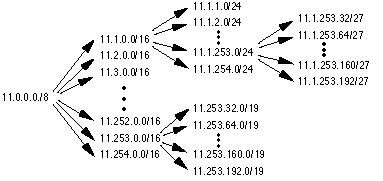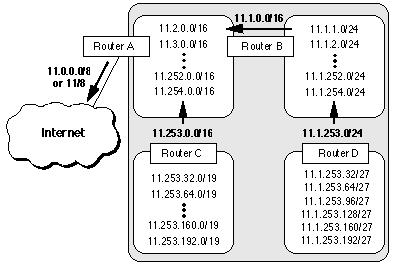
Figure 17: VLSM Permits the Recursive Division of a Network Prefix




Route Aggregation
VLSM also allows the recursive division of an organization's
address space so that it can be reassembled and aggregated to reduce the amount
of routing information at the top level. Conceptually, a network is first divided
into subnets, some of the subnets are further divided into sub-subnets, and some
of the sub-subnets are divided into sub 2 -subnets. This allows the detailed structure
of routing information for one subnet group to be hidden from routers in another
subnet group.
11.0.0.0./8 11.1.0.0/16
11.2.0.0/16
11.3.0.0/16
11.252.0.0/16
11.253.0.0/16
11.254.0.0/16 11.1.1.0/24
11.1.2.0/24
11.1.253.0/24
11.1.254.0/24
11.253.32.0/19
11.253.64.0/19
11.253.160.0/19
11.253.192.0/19 11.1.253.32/27
11.1.253.64/27
11.1.253.160/27
11.1.253.192/27

Figure 17: VLSM Permits the Recursive Division of a Network Prefix
In Figure 17, the 11.0.0.0/8 network is first configured with a /16 extended-network-prefix. The 11.1.0.0/16 subnet is then configured with a /24 extended-network-prefix and the 11.253.0.0/16 subnet is configured with a /19 extended-network-prefix. Note that the recursive process does not require that the same extended-network-prefix be assigned at each level of the recursion. Also, the recursive sub-division of the organization's address space can be carried out as far as the network administrator needs to take it.

Figure 18: VLSM Permits Route Aggregation - Reducing Routing Table Size
Figure 18 illustrates how a planned and thoughtful allocation of VLSM can reduce
the size of an organization's routing tables. Notice how Router D is able to summarize
the six subnets behind it into a single advertisement (11.1.253.0/24) and how Router
B is able to aggregate all of subnets behind it into a single advertisement.
Likewise, Router C is able to summarize the six subnets behind it into a single
advertisement (11.253.0.0/16). Finally, since the subnet structure is not visible
outside of the organization, Router A injects a single route into the global
Internet's routing table -11.0.0.0/ 8 (or 11/8).